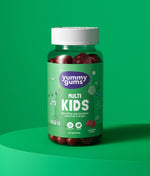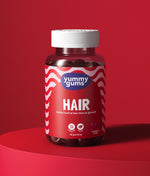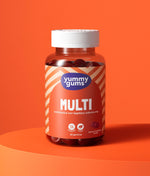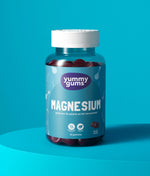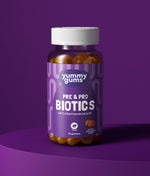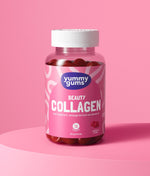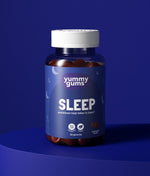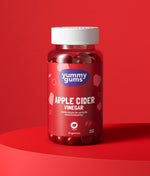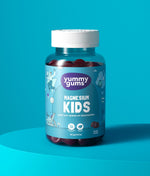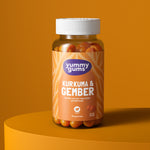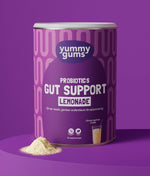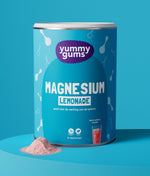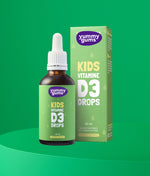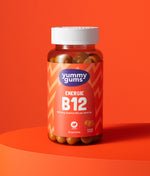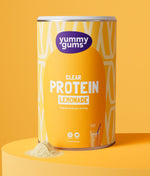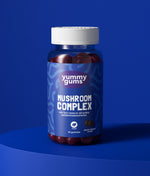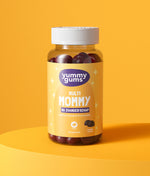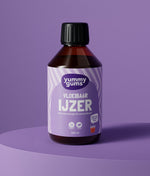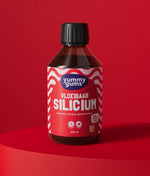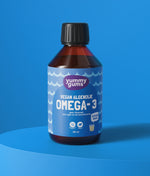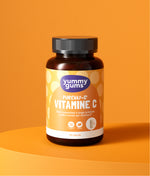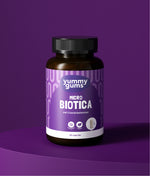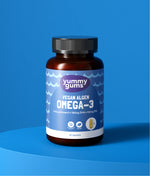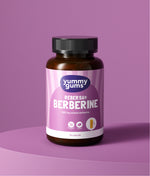Vitamin gummies: everything you need to know
Vitamines
Table of contents
Vitamin supplements
What are vitamins?
Why should you take vitamins?
The absorption of vitamins
Pills, tablets, drops or gummies
The vitamin gummy
Medical advice
Ingredients
Recommended Daily Allowance (RDA)
Bibliography
Vitamin supplements
Vitamin supplements are a common way to supplement your diet. However, this doesn't mean a supplement is a replacement for food. Supplements like tablets, drops, or gummies do contain vitamins and minerals, but lack fiber and bioactive ingredients. Taking supplements is a practical way to ensure you get enough of all your vitamins and minerals.
A healthy diet should ensure we get enough vitamins. According to the Netherlands Nutrition Centre, you eat healthily when you eat a wide variety of foods and follow the Wheel of Five as a guideline. This means: lots of vegetables, fruit, whole grains, beans, oil, and nuts. But also not too much dairy, less meat, and only occasional sweets or soda. In theory, you get enough vitamins and minerals this way, but in practice, it's unfortunately not that simple. For example, the same Food Consumption Survey shows that the Dutch don't eat enough vegetables.
There are also specific groups at increased risk of deficiencies. Vegans, pregnant women, children, people who don't spend much time outdoors, cover their skin, have dark or tinted skin, and the elderly generally don't get enough vitamins through their diet. Individuals with these characteristics are particularly at increased risk of vitamin D, B12, K, or folic acid deficiencies. Therefore, specific supplementation recommendations have been established for these groups, but even if you don't fall into these groups, a supplement can be a useful addition. Provided, of course, that you follow the recommended dosage stated on the packaging.
* Yummygums Multi+ is now available in our webshop!

What are vitamins?
You can find them in food, drinks, and supplements: vitamins. But what exactly are vitamins, and why do you need them? Your body uses vitamins to grow, develop, and stay healthy. They are micronutrients , and unlike macronutrients, they don't provide your body with energy on their own. However, vitamins do ensure you can extract energy from the macronutrients: they function as catalysts. This means they play a vital role in ensuring the proper functioning of countless processes in your body.
Your body can (partially) produce some vitamins itself. These are the fat-soluble vitamins: vitamins A, D, E, and K. Vitamin D is produced in the intestines, and your skin produces vitamin D when it comes into contact with sunlight. Provitamins (vitamin precursors) in your diet help with this. For example, your body converts provitamin A (carotenoids) and provitamin D into vitamins A and D. But there are also several vitamins you cannot produce or store yourself. These are the water-soluble vitamins. If you consume too much of these, you simply pee them out. It is therefore essential that you get these regularly—preferably daily—through food or a supplement. These vitamins include vitamin B1, B2, B3, B5, B6, B7, B11, B12, and vitamin C. While these vitamins are excreted through urine when consumed in excess, this doesn't mean that overconsumption can't be harmful to your health. Therefore, Yummygums uses very precise vitamin dosages, and it's important to stick to the recommended dose.
Why should you take vitamins?
If we ate perfectly composed meals every day, there wouldn't be a need for supplements. But ensuring you incorporate all the vitamins and minerals into your lifestyle every day isn't always easy. 26 percent of Dutch people get the recommended two pieces of fruit per day, and overall, a quarter of the population eats according to the Health Council's Good Nutrition Guidelines . While this only covers a small part of the research, it shows that most Dutch people find it difficult to get all the vitamins and minerals they need every day. The exact nutrients you're missing, and the adjustments you need to make to prevent a deficiency, vary from person to person. Fortunately, there are guidelines that apply to almost everyone. With this in mind, Yummygums developed the multivitamin Multi +: a vitamin gummy that supports daily vitamin needs for both children and adults. With 17 balanced vitamins and minerals, Multi Plus is an easy (and delicious!) way to ensure you get enough micronutrients.
The absorption of vitamins
Another reason to consider vitamin supplements is their high absorption rate. Your body absorbs certain vitamins from dietary supplements better than vitamins from food. For example, the absorption of folic acid (vitamin B11) from food is approximately 30 to 50 percent lower than that from a supplement (Radar, 2019). In most cases, there is no difference between vitamins found in food and those obtained from a supplement, except for vitamins D, B5, B6, B12, and folic acid. It is known that the supplement form of these vitamins is significantly better absorbed. Incidentally, the opposite is true for vitamin E: the natural form is more easily absorbed by your body.
Another factor that plays a role in vitamin absorption is the supplement's content. This varies by brand. "More expensive is better" doesn't apply to supplement quality: a better indicator is the ratio of organic to inorganic compounds. These determine how well your body can absorb vitamins and minerals. This is a technically complex matter, but a useful rule of thumb is: "the less the label explains about the ingredients, the lower the quality generally is" (Radar, 2019).
Pills, tablets, drops or gummies
There are various forms of vitamin supplements. Pills, like paracetamol, can be swallowed. Effervescent tablets can be dissolved in water, and chewable tablets can be chewed, or crushed, and stirred into yogurt. There are also drops or sprays, which you apply directly to the tongue. But the most flavorful option is a vitamin gummy: a type of wine gum containing vitamins and minerals. You can easily halve a gummy if, for example, you're worried it might be too large for a young child to chew.
Besides the way you take a supplement, the variants also differ in terms of ingredients. Since the European Food and Consumer Product Safety Authority (EFSA) assessed the claims on supplement labels, you can assume they are accurate. All permitted claims are recorded in a database maintained by the Inspection Council for Public Advertising of Medicines (KOAG) and the Inspection Council for Advertising of Health Products (KAG). This council oversees the public advertising of health products, including dietary supplements (Vitamin Information Bureau, 2019). The Netherlands Food and Consumer Product Safety Authority (NVWA) also monitors the safety of food and health products (Nutrition Centre, 2019).
The vitamin gummy
Everyone has seen or used supplements in the form of pills or tablets, and how to use drops is also self-explanatory. But what exactly are gummies, and what are they made of? Gummies are a soft candy made with gelatin, pectin, or starch (better known as starch). Gelatin is the term for proteins derived from the bones and cartilage of primarily mammals (often cattle or pigs). Pectin is found in the cell walls of apples and pears, for example. Starch is a carbohydrate found in potatoes and grain products, among other things. The latter two ingredients are completely plant-based and vegan. Yummy gummies are made with a pectin base and are therefore suitable for vegans and other plant-based diets. It's no wonder gummies are becoming increasingly popular: you can't taste that they're a supplement and they're indistinguishable from candy. This means you're less likely to forget a vitamin gummie and never have to ask your children more than once for their daily vitamin boost. If the candy is too big, it can easily be halved, as mentioned before.
Medical advice
Even though a gummy tastes just like candy, you're unfortunately not supposed to eat it in unlimited quantities. While it's important to get enough vitamins and minerals, too much can be harmful to your health. Therefore, the Health Council has established a guideline: the recommended daily allowance (RDA). You can read more about the RDA under the heading "Recommended Daily Allowance (RDA)."
Tolerable upper limit – maximum dosage per day (adults > 18 years)
| Vitamin A | 3,000 micrograms |
| Vitamin D | 100 microgram |
| Vitamin E | 300 milligram |
| Niacin (vitamin B3) | 900 milligrams* |
| Vitamin B6 | 25 milligrams** |
| Folic acid | 1,000 micrograms |
1 milligram (mg) is equal to 1,000 micrograms (mcg).
* This applies to nicotinamide, which is the form primarily found in food and supplements. For nicotinic acid, a tolerable upper limit of 10 milligrams per day applies.
** As of October 1, 2018, supplements in the Netherlands may not contain more than 21 milligrams of vitamin B6.
An acceptable upper limit is determined based on one of the two levels below:
The highest level of intake at which no harmful effects occur. This level is called NOAEL: No Observed Adverse Effect Level.
The lowest intake level at which adverse effects have been observed. This level is called LOAEL: Lowest Observed Adverse Effect Level.
The tolerable upper limit (TLE) is then determined using an uncertainty factor. The uncertainty factor acts as a buffer, minimizing the risk of harmful effects. Therefore, the TLE remains below the NOAEL or LOAEL. The figure below illustrates this. It also shows the correlation with the average requirement , recommended daily allowance , and adequate intake (Health Council of the Netherlands, 2003).
A health risk only exists if you exceed the tolerable upper intake level for a prolonged period. A one-time or short-term excess will almost never lead to an immediate health problem (Nutrition Centre, 2019). If you're still wondering how much of each vitamin you should have, what the safe upper intake level is, and which groups should be careful with certain vitamins, you can find information here. This website, run by the Vitamin Information Bureau, uses the guidelines of the Health Council and provides additional explanations.
Yummygums jars have a safety cap to prevent young children from having unlimited access to vitamin supplements.
Ingredients
There are 13 substances called "vitamins." It's easiest to divide them into two groups: fat-soluble and water-soluble vitamins. Vitamins A, D, E, and K (also known as KADE, a handy mnemonic) are fat-soluble. These vitamins are primarily obtained from fat-containing products, such as spreads and cooking fats, fish, meat, nuts, and dairy products. Water-soluble vitamins are a larger group. This group consists of vitamin C (ascorbic acid), B1 (thiamine), B2 (riboflavin), B3 (niacin), B5 (pantothenic acid), B6 (pyridoxine), B8 (biotin), B11 (folic acid), and B12 (cobalamin). These vitamins are obtained from vegetables, fruit, grains, nuts, legumes, and dairy products.
Some vitamins also fall into the category of " antioxidants ." These are substances that help protect your cells and tissues from harmful substances. Provitamin A (beta-carotene), C, and E are antioxidants. A provitamin is a compound like beta-carotene that can be converted into, in this case, vitamin A. Your body can only store vitamins that are fat-soluble. Water-soluble vitamins are not stored; they are excreted through urine. However, this doesn't mean you can consume these in unlimited quantities without consequences: during the time a substance is in your body, it can also trigger certain reactions. For example, you excrete vitamin B6 in your urine, but taking too high a dose for a long period can be harmful to your nervous system (Consumentenbond, 2019).
Vitamins aren't the only micronutrients. Besides vitamins, there are also minerals: calcium, chromium, chloride, fluoride, phosphorus, iron, iodine, potassium, copper, magnesium, manganese, molybdenum, sodium, selenium, and zinc. To get an idea of what a multivitamin (gummy) can contain, you can check the ingredients list for Yummygums Multi Plus.
Recommended Daily Allowance (RDA)
RDA stands for Recommended Daily Allowance (RDA). In the Netherlands, the Health Council determines the RDA for a nutrient, such as a vitamin or mineral. These recommendations serve as a benchmark for the daily amount healthy people need. The RDA for children, men, and women varies because these groups also have different nutrient needs. To determine the RDA, the number of bodily processes in which the nutrient is involved is considered. These include metabolism, supporting brain function, releasing energy from food, and so on. The RDA is an amount that is sufficient for almost the entire population. Those who adhere to the RDA generally get enough vitamins and minerals. Read more about the RDA or view the complete overview of the RDA for vitamins and minerals for different age groups (Voedingscentrum, 2019).
Please note: only use vitamin supplements if you need them and follow the instructions for use. Read more about this under "Medical Advice." If you have any questions, you can always contact the Consumers' Association via this link.

